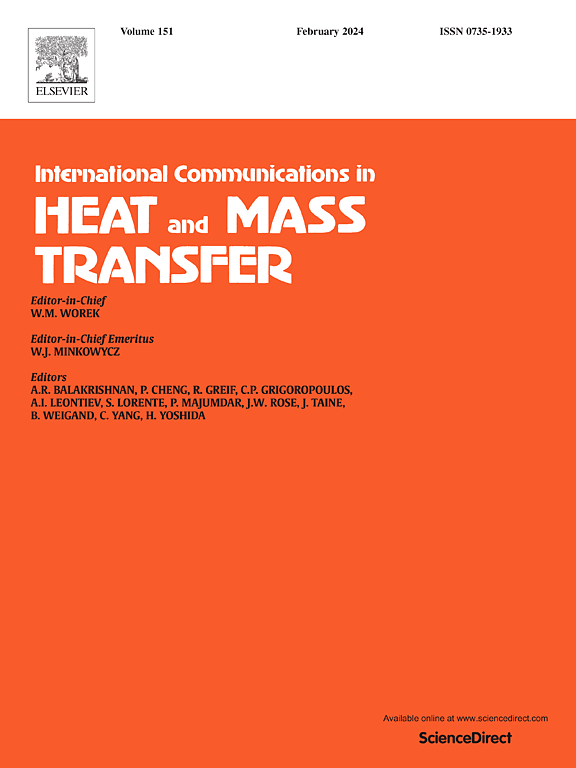相变材料优化策略的综合综述:技术、应用和在储热系统中的挑战
IF 6.4
2区 工程技术
Q1 MECHANICS
International Communications in Heat and Mass Transfer
Pub Date : 2025-05-30
DOI:10.1016/j.icheatmasstransfer.2025.109123
引用次数: 0
摘要
相变材料(PCMs)由于其高潜热容量而在热能储存系统中具有广泛的潜力。然而,它们的实际应用受到低导热性的显著阻碍,这限制了能量的充放电速率。这篇综述提供了一个全面的和关键的合成最近发展的被动技术,以提高pcm的热性能。这些包括鳍状结构、多孔介质、纳米颗粒分散、几何修改和多pcm策略。定量比较表明,使用翅片可以减少65%的熔化时间,而金属多孔基质可以提高500%以上的导热性。纳米颗粒的掺入证明了传热率提高了25%,尽管粘度增加了。几何创新和多pcm分层实现了跨温度范围的定制热响应,适用于太阳能热系统和建筑集成储能等应用。此外,本综述确定了与每种方法相关的权衡,包括设计复杂性、成本和材料兼容性,并提供了一个比较性能表,以指导基于系统需求的选择。混合增强策略,如纳米粒子掺杂的pcm嵌入金属泡沫中,也被认为是未来研究的一个有前途的方向。该报告总结了具体的、前瞻性的见解,强调了基于pcm的解决方案在太阳能海水淡化、冷链运输和现实世界限制下的被动式建筑冷却方面的机会。本文章由计算机程序翻译,如有差异,请以英文原文为准。
Comprehensive review of optimization strategies for phase change materials: Techniques, applications, and challenges in thermal storage systems
Phase Change Materials (PCMs) are widely recognized for their potential in thermal energy storage systems due to their high latent heat capacity. However, their practical application is significantly hindered by low thermal conductivity, which limits the charging and discharging rates of energy. This review provides a comprehensive and critical synthesis of recent passive techniques developed to enhance the thermal performance of PCMs. These include finned structures, porous media, nanoparticle dispersion, geometrical modifications, and multi-PCM strategies. Quantitative comparisons show that the use of fins can reduce melting time by up to 65 %, while metallic porous matrices can improve thermal conductivity by over 500 %. Incorporation of nanoparticles has demonstrated up to 25 % enhancement in heat transfer rates, albeit with increased viscosity. Geometrical innovations and multi-PCM layering have enabled tailored thermal responses across temperature ranges, suitable for applications such as solar thermal systems and building-integrated energy storage. Furthermore, this review identifies trade-offs associated with each method, including design complexity, cost, and material compatibility, and presents a comparative performance table to guide selection based on system requirements. Hybrid enhancement strategies, such as nanoparticle-doped PCMs embedded in metal foams, are also proposed as a promising direction for future research. The review concludes with specific, forward-looking insights, highlighting opportunities for PCM-based solutions in solar desalination, cold-chain transport, and passive building cooling under real-world constraints.
求助全文
通过发布文献求助,成功后即可免费获取论文全文。
去求助
来源期刊
CiteScore
11.00
自引率
10.00%
发文量
648
审稿时长
32 days
期刊介绍:
International Communications in Heat and Mass Transfer serves as a world forum for the rapid dissemination of new ideas, new measurement techniques, preliminary findings of ongoing investigations, discussions, and criticisms in the field of heat and mass transfer. Two types of manuscript will be considered for publication: communications (short reports of new work or discussions of work which has already been published) and summaries (abstracts of reports, theses or manuscripts which are too long for publication in full). Together with its companion publication, International Journal of Heat and Mass Transfer, with which it shares the same Board of Editors, this journal is read by research workers and engineers throughout the world.

 求助内容:
求助内容: 应助结果提醒方式:
应助结果提醒方式:


